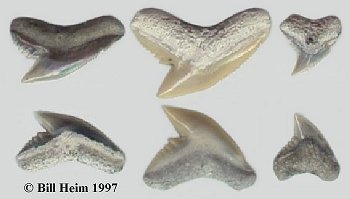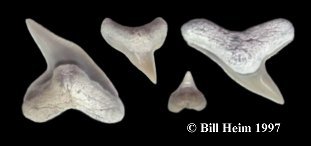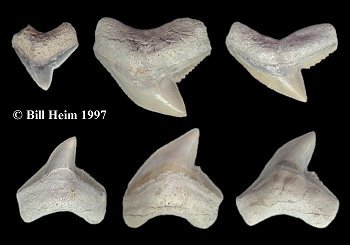|

Ward & Bonavia (2001) argued that the teeth long ascribed to Galeocerdo contortus were
in fact those of the extinct genus Physogaleus. This tooth-design is so similar to
Physogaleus and dissimilar to Galeocerdo that it was difficult to disagree with their
conclusions. However, they went on to ascribe Agassiz's G. aduncus to Physogaleus
then synonymized contortus with aduncus. Was Lee Creek now without a Miocene tiger shark?
Ward (pers com 2003) indicated that there is still a Miocene tiger, but those teeth
(looking like small cuviers) can be differentiated from the Agassiz type for aduncus.
This matter has not been fully explained to the satisfaction of the authors (who don't
agree amongst themselves). For the time being, these two genera will be included on the
same page.
Tiger shark teeth are abundant at the mine, particularly in the Pungo River.
These teeth are very useful because they can serve
as index fossils when working mixed tailings. "Galeocerdo" aduncus and Physogaleus "contortus"
are Pungo River species and G. cuvier, a Yorktown species. P. "contortus" teeth
(usually worn) occasionally appear in the basal Yorktown -- these may be reworked
Pungo river teeth.
"Galeocerdo" aduncus (AGASSIZ, 1843)
A very common tooth in the Pungo River formation. It is very similar in appearance to
G. cuvier but is much smaller and less massive.
 |
Fig. 1 - "Galeocerdo" aduncus
(lingual view) from the Pungo River.
Largest tooth in the image:
21 mm wide. |
Physogaleus "contortus" (GIBBES, 1849)
Another common tooth in the Pungo. This tooth is much thicker in cross section than
"G". aduncus and has a noticable twist (contorted) in the tip of blade when looking
down along it. Unlike "G". aduncus which may have continued to evolve into G. cuvier,
"contortus" had reached its high water mark. Extremely common in the mid-Miocene, by
the late Miocene, it was very rare and had become extinct by the Pliocene.
 |
Fig. 2 - Physogaleus "contortus"
(lingual view) from the Pungo River formation. |
Galeocerdo cuvier (PERON & LESUER, 1822)
 It is very difficult to distinguish uppers from lowers in tiger sharks, even
in a modern jaw the uppers are virtually indistinguishable from the lowers.
Also note the tremendous variability in symphyseal teeth. They may be symetrical
or assymetrical and differ greatly in size even in the same shark. Tiger sharks also
have a high percentage of pathologic teeth.
It is very difficult to distinguish uppers from lowers in tiger sharks, even
in a modern jaw the uppers are virtually indistinguishable from the lowers.
Also note the tremendous variability in symphyseal teeth. They may be symetrical
or assymetrical and differ greatly in size even in the same shark. Tiger sharks also
have a high percentage of pathologic teeth.
 |
Fig. 3 - Galeocerdo cuvier
(lingual view) from the Yorktown.
The largest tooth in the image is
32mm wide x 34 mm slant height. |
|